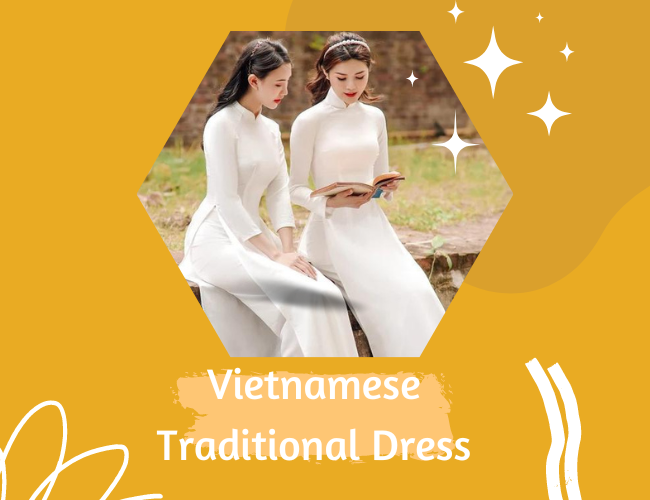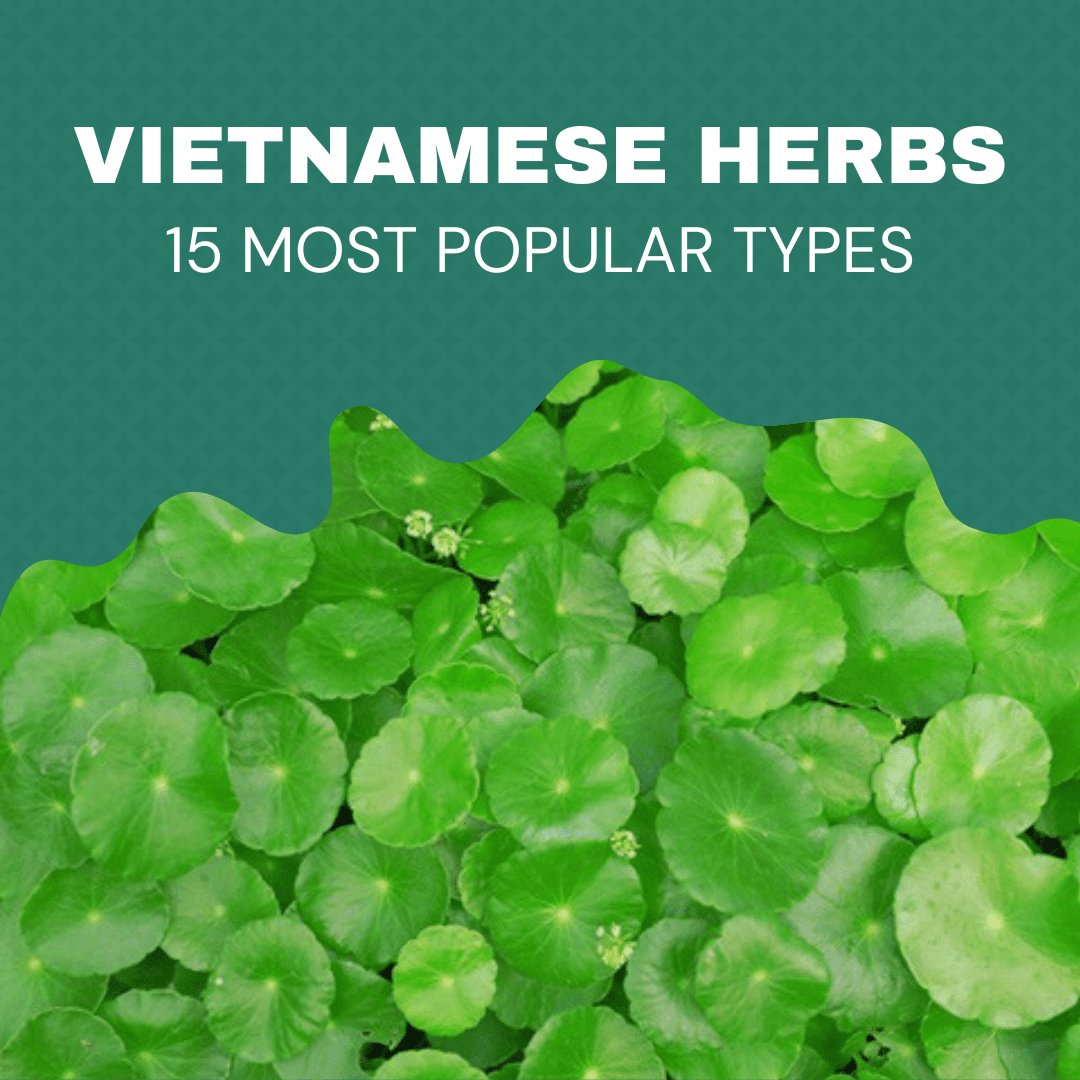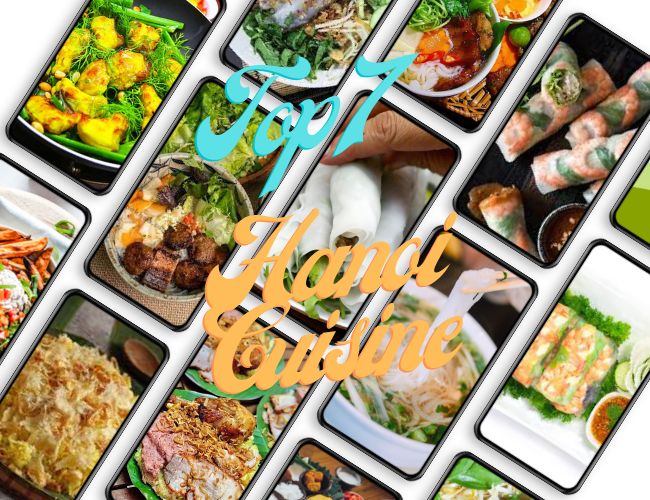Besides cuisine and language, costumes are also a key aspect in presenting the identity and cultural values of Vietnam.
With 54 different groups across three main regions, Vietnam is known as a multiethnic country. Despite differences across regions and ethnics, Vietnamese traditional dress and costumes perfectly present the historical and cultural values of their people.
This article is an overview of general Vietnamese traditional dress and costumes, as well as those of different regions and ethnic groups.
General Vietnamese Traditional Dress For Female & Male
Ao Dai (Female)
Known as the official national Vietnamese garment, the Ao Dai has been worn by both men and women on formal occasions for hundreds of years now. Invented during the Nguyen Dynasty and after a long period of evolution, this Vietnamese traditional dress became Ao Dai today.
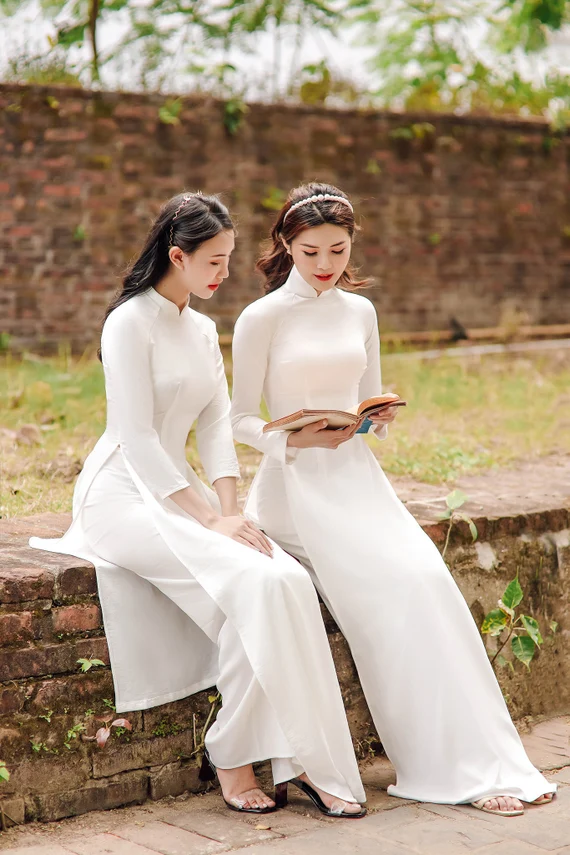
The Ao Dai for women looks a bit more like a dress than a tunic. This Vietnamese traditional dress is tight and fitted from neck to hips, and flows down to ankles. It has two main versions: one is the four-flap (“tu than”) flowing tunic that is tied together in the front, and another is the five-part (“ngu than”) flowing tunic that has an added flap that is buttoned up onto the right side of the garment.
The color of a typical Ao Dai for women is various based on the wearer’s preference, occasions, and age. Moreover, this Vietnamese traditional dress is required as a uniform for female students in many high schools across Vietnam. It is usually white and with a name tag on the left side of the chest.
Ao Dai (Male)
Though the Ao Dai for women is more popular, it is also worn by men. This Vietnamese traditional dress for both men and women is made of the same material, which is silk with a traditional upright collar and buttons running down on the left side. Regarding the length, the male Ao Dai extends to the knees, different from the flaps of the female garment, which run down to the ankles.
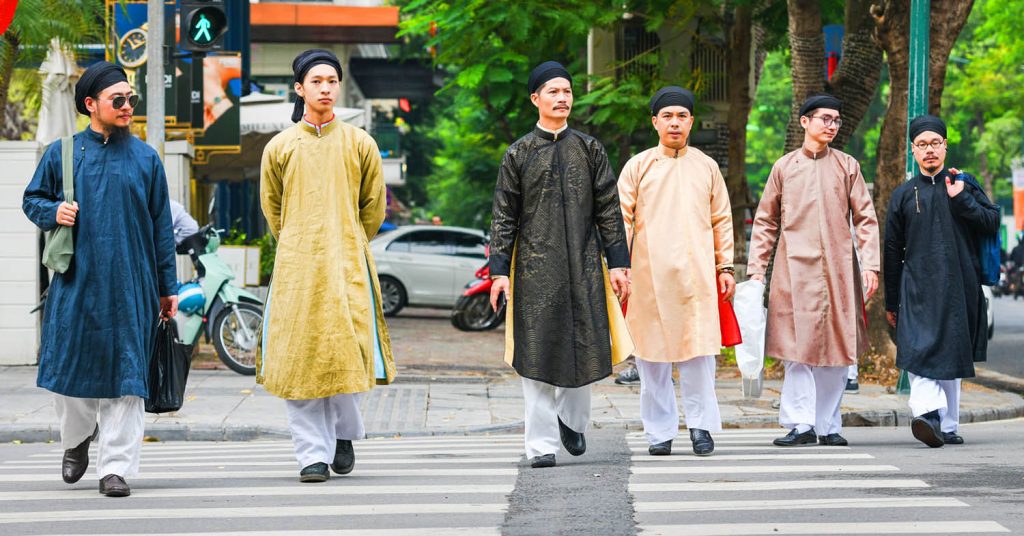
In the past, especially in the feudal period, the color of male Vietnamese traditional dress varied according to the wearer’s social footholds. Ao Dai with gold color and dragon embroidery patterns were presented for the king, while that with purple color is used by high-ranking court mandarins. Blue Ao Dai was also for mandarins but at a lower rank.
Nowadays, though people are more familiar with Western-style clothes, the graceful Vietnamese traditional dress – Ao Dai, remains popular and loved during traditional and formal occasions such as Lunar New Year or engagement ceremonies.
Besides the general garment for the whole nation, each region and ethnic has its own tailored versions. Keep reading to see how Vietnamese traditional dress and costumes vary across parts of the country.
Ao Tu Than- Vietnamese Traditional Dress and Costume in Northern Vietnam
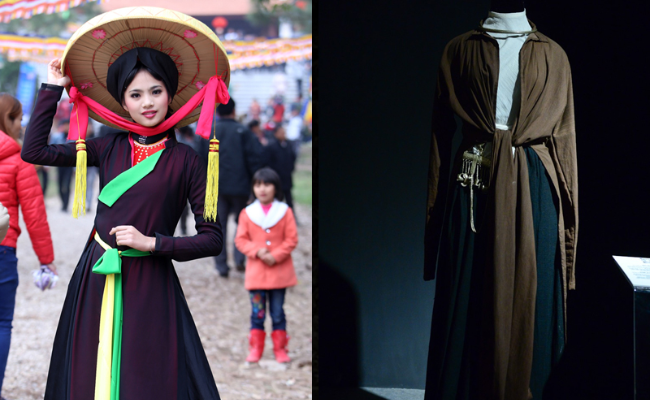
In the north of Vietnam, women wear the four-part version of Ao Dai (called “ao tu than”) over a long skirt. This Vietnamese traditional dress includes three main parts: a bodice (called “yem”) worn as underclothing by women to cover the chest area, a long skirt, and a flowing tunic. The tunic is separated into four parts (four means “tu”, part means “than”). This Vietnamese traditional dress usually goes with a large hat made of leaves, called “non quai thao”, or simply a dark-colored headscarf and wooden clogs.
Today, this Vietnamese traditional dress is no longer worn in daily life by the locals. However, it is widely seen during local special festivals such as Lim festivals in Bac Ninh (one of the greatest festivals in Vietnam) or performances like Tuong or Cheo. While the daily “ao tu than” usually features neutral colors, this northern Vietnamese traditional dress appears more vivid and vibrant on special occasions as the three parts of the set have different colors.
Vietnamese Traditional Dress and Costume in Central Vietnam
The Vietnamese traditional dress in central Vietnam is a long flowing tunic worn over loose-fitting trousers. The tunic splits into a front and back flap from the waist. The trousers can be in any color, from black, white to other vibrant hues. This traditional garment is said to “cover everything but hide nothing” as it gracefully promotes the elegant curves of Vietnamese women without being revealing.

The costume is usually seen with a conical hat made of palm leaves (called “non la”), which protects the wearer from rain or sun. This item is familiar with tourists in the central provinces such as Hue and Hoi An, where foreign tourists usually buy it as a souvenir.
Ao Ba Ba – Vietnamese Traditional Dress and Costume in Mekong Delta
The Vietnamese traditional dress in Mekong Delta features some characteristics different from those of northern and central regions, regarding the main set of clothes and accessories. The costume is called Ao Ba Ba, literally translated as “the shirt of madame Ba”, widely worn in the southwestern countryside of Vietnam, along the banks of the Mekong river.
The Ao Ba Ba is a set of a round-neck shirt paired with long black or white trousers. The front panel of the shirt is comprised of two separate flaps, with a row of buttons running down from the neck to the belly; while the back panel is made of a straight piece of cloth.
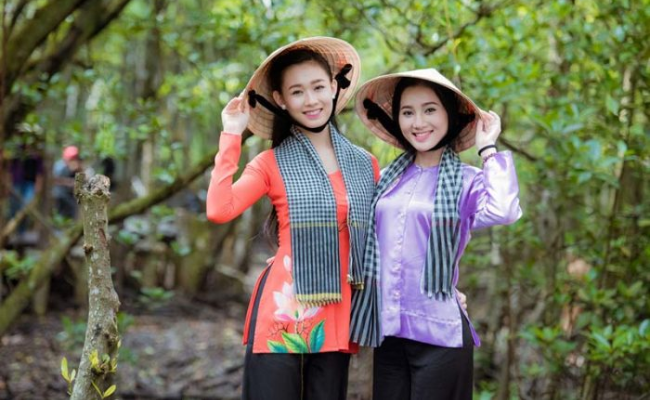
The color and materials of this Vietnamese traditional dress set are diverse.
Peasants are often seen in Ao Ba Ba with dark colors such as brown or black, as these shades appear clean when working in the field. Unlike the north and central regions, the majority of Ao Ba Ba types are made of simpler fabrics, normally pungent fabrics or linoleum, which quickly dry after being washed.
However, bright colors and expensive materials like silk or satin are also chosen to make Ao Ba Ba for the nobles, so as to showcase their wealth.
Going with this dress is an iconic accessory, a checked scarf (or a bandana). It is mostly black and white, sometimes brown and white, not so striking but makes a symbolic picture when paired with Ao Ba Ba.
As convenient and comfortable as it is, this costume is preferred by both local men and women in their daily life. Visiting the areas in the Mekong Delta, you can easily run into men or women wearing Ao Ba Ba when working on the field, walking on the streets, or sailing the boat along the river. On special occasions, Ao Ba Ba with lighter colors such as white or ash grey is preferred.
Vietnamese Traditional Clothing For Ethnic Minorities
Not only are Vietnamese traditional dress and costumes distinct in different regions but also various across ethnic groups. Thai, H’Mong, and Cham are among 54 ethnic groups whose costumes feature the identities and cultural values of their people.
Thai Ethnic Group
When visiting northwestern provinces in Vietnam (Dien Bien, Lai Chau, Son La), you’ll see the community of Thai ethnic groups and will be amazed by Thai women in their dress. The set normally includes a fitting white blouse and a black long skirt. Traditionally, the white Thai people wear a white blouse with a V-shaped collar, while the black Thai people wear a black blouse with a high collar. Besides, a fabric belt, made of pink, blue or green cloth, is used to connect the top and bottom.
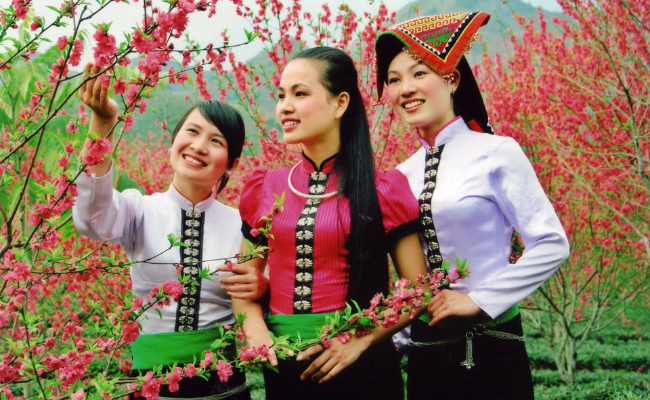
This set of Vietnamese traditional dress normally goes with a special brocade head scarf called “khan pieu”, along with some silver accessories, making the whole look more elegant.
H’mong Ethnic Group
H’mong is the eighth largest minority ethnic group in Vietnam. Their people live in provinces of northern and western Vietnam, like Ha Giang, Son La, Lai Chau. The traditional dress of H’mong women is rich in details and colors, normally made of linen with many striking colors and embroidered patterns.
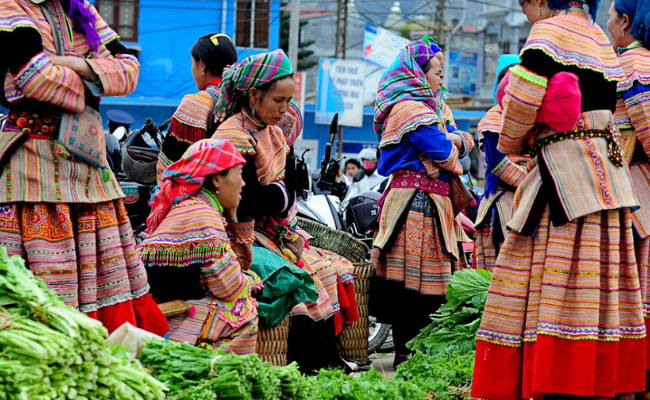
This traditional dress includes a deep V-neck shirt, overall of two large pieces covering the front and the back, leggings, a big belt, a headscarf, and a truncated cone-shaped gathered skirt. To embellish the whole set of costumes, H’mong women usually wear silver accessories like earrings, bracelets, and necklaces.
Cham Ethnic Group
Cham people live along the central and southern coast of Vietnam, with a rich culture influenced by Indians. Unlike Vietnamese traditional dress and costumes of other ethnic groups, the attire of Cham people is less colorful and striking.
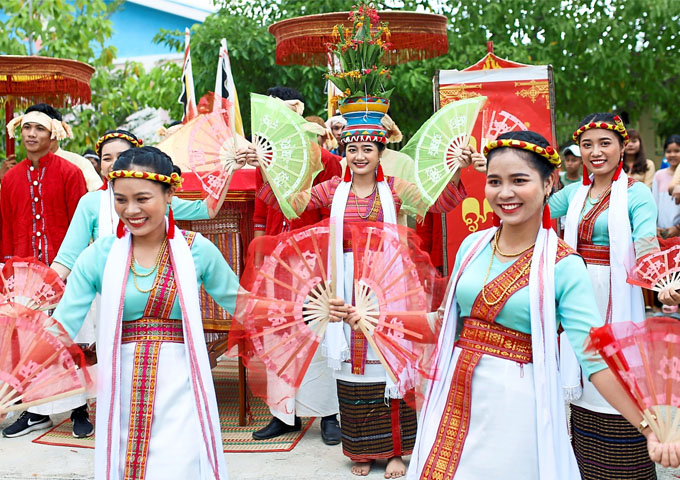
Both Cham men and women wear long one-piece sarongs or cloth wrappers. While male shirts have buttons running down, female tops are long-sleeved pullover blouses. A waistband is used to tie across the chest and around the waist. This is usually the highlight of the costume as it is shimmering golden and with meticulous patterns. People wear this on special occasions and white versions of it in religious masses.
Final Thoughts
While Ao Dai is the official national costume, many exquisite versions of Vietnamese traditional dress are being worn by men and women across the territory. Each of them narrates different cultural and historical stories of their land and their people.

